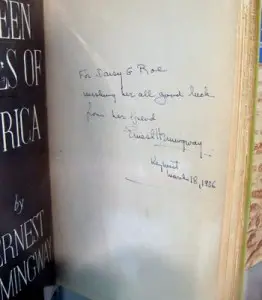Wow, this book has been signed by the author! It must be worth a lot!
Not so fast, is that a real signature? A real signature can vastly increase the price on a book while a forgery can ruin a good copy.
 One of the most common errors people make is mistaking a printed signature for an actual signature. These are pretty common, especially with super popular authors. It’s purely decorative. The easiest way to tell if it’s a printed signature is to turn the page and run your fingers over it.
One of the most common errors people make is mistaking a printed signature for an actual signature. These are pretty common, especially with super popular authors. It’s purely decorative. The easiest way to tell if it’s a printed signature is to turn the page and run your fingers over it.
There’s often a little bleed through onto the back of the page, so look though the page at a light source. If it’s uniformly dark, it’s probably printed. If it’s irregular, odds go up that its a real signature. If there’s actual bleed through of the ink in irregular spots, its almost certainly a signature.
The other trick is to run your fingers over the signature, front and back. First run your fingers flat, then make claws with your hands to run your nails over it lightly. Run your fingers over a printed section, then over the signature. A printed signature will feel uniform. A signature will have some indentations if if was done with a pointed pen. A felt tip pen signature will be smooth but will have bleed spots you can see from front and back.
If the ink used in the signature is a different color than the rest of the text, this also makes it likely it’s a signature.
Great, you have a signature! But is it the author’s signature?
One of the quickest things to check is print date vs author’s death date. If it was printed afterward, it’s definitely not real!
Wikipedia often has a sample signature for well known authors on the page about the author. For example, the page on J.D. Salinger shows off what Salinger’s signature is supposed to look at. Not every author has a representative signature, but it’s often a good first stop for well known authors. A little searching on the internet should turn up lesser known authors signatures as well. Looking through multiple signed copies on book selling sites can also give you a good idea of what it’s supposed to look like.
If it looks NOTHING like the author’s signature, it’s obviously a poor forgery. However, it probably won’t look quite like the sample one either. Authors often sign big stacks of books at a time or sign them at an awkward height or on unsteady surfaces. If it doesn’t exactly match, it may still be the author. You’re looking for something that looks similar, but isn’t an exact clone.
One that looks EXACTLY like the representative samples you’re seeing online should raise a red flag. Print out the signature and lay it over your suspected signature. Put a flashlight behind the two pages. If it lines up EXACTLY, you may have a forgery. Printing out a copy and using carbon paper to trace on the signature isn’t exactly hard. Trace over the signature, then go over it with a pen and you appear to have a real signature.

